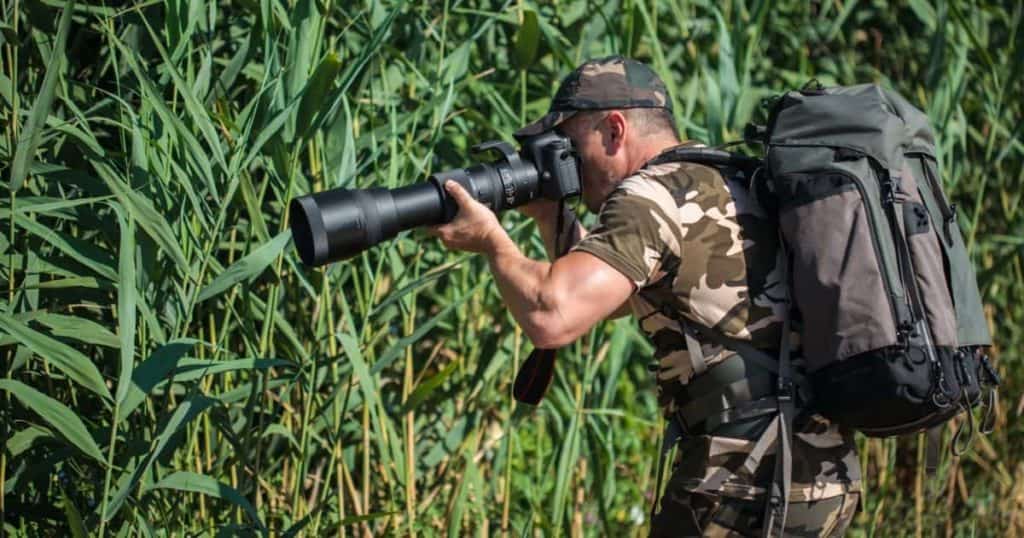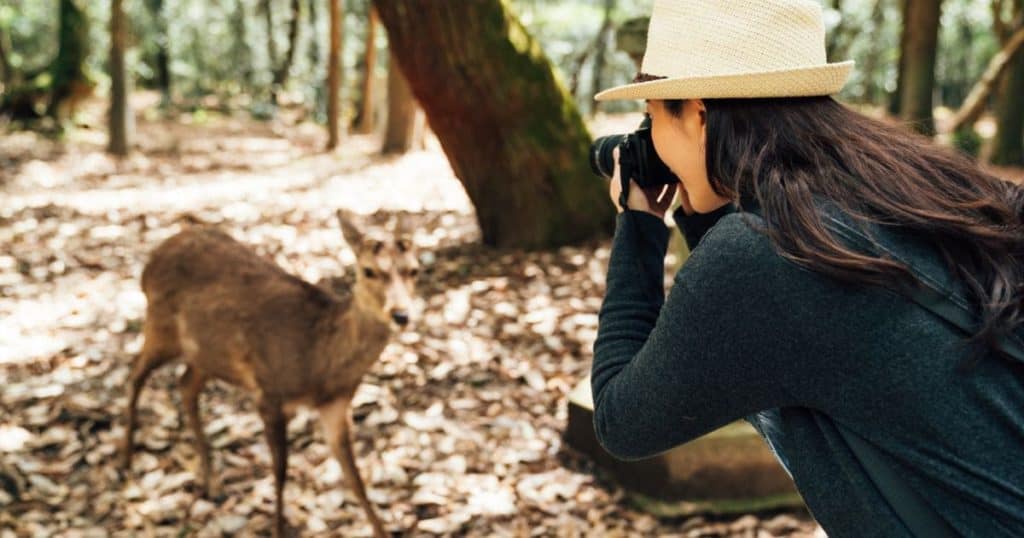If you’re wondering how to become a wildlife photographer, we should first dive into the meaning of wildlife photography. There are many genres of photography – including food, nature, landscape, architecture, and so on.
A lesser-known but perhaps more exciting genre of photography is wildlife photography. It includes unwilling subjects, remote locations, distant travel, different seasons, and rare moments.
Wildlife photography documents the life of undomesticated animal species in their natural habitats, which makes this genre of photography all about location and timing. For these reasons, wildlife photographers have more than just photography skills under their belt – they are also animal lovers, nature specialists, risk-takers, ethologists, and more!
Wildlife Photography: A Short History

When the first camera was invented in the 19th century, the lenses were slow and even the slightest movement caused blurring. For this reason, it was nearly impossible to capture a wild animal on camera.
The first pictures of animals were either pictures of pets and domesticated animals or pictures of animals in captivity. Capturing wild animals on camera was nearly impossible, until the late 19th century when new technologies came on the market.
Photographers continued to be fascinated with wildlife, and with more sophisticated cameras the expansion of wildlife photography occurred. The 19th century brought some of the most famous animal photography like, ‘Jump' by Rodchenko and ‘Rising Dove' by Edgerton. Photos of animals continue to amaze us to this day.
How to Become a Wildlife Photographer
As for any professional photographer with any type of photography, quality equipment is required. Because of the peculiarity of wildlife photography, a fast-speed camera and adequate equipment are particularly important.
In terms of the camera, you will need a digital single-lens reflex (DSLR) camera. A DSLR camera will give you sharp photos and the possibility to edit the photos later. If you don't own a camera, you should look for one with in-body image stabilization (IBIS) and good autofocus (AF).
In addition to a quality camera, wildlife photographers will find the following things useful:
- A 200 mm telephoto lens or longer: A telephoto is a type of long-focus lens in which the physical length of the lens is shorter than the focal length of the lens. Telephoto lenses help to capture objects at a greater distance, which is necessary for most species that don't let humans approach them up close.
- Tripods or monopods: Photographers use tripods and monopods to stabilize their telephoto lenses, as they can be very heavy. The best tripods and monopods are lightweight since you will need to carry them to your location.
- Gimbals: Some photographers use gimbals instead of tripods as it allows more movement and flexibility
- Memory cards: It's important to get fast memory cards, as they need to be able to write fast enough for the burst of photos at the right time. Write speed should be at least 150MB/s. The faster the card, the more expensive it is.
- Spare batteries: Since you may have to wait for long periods to capture animals in nature, you may not be able to recharge your batteries. You should always have extra batteries on hand.
Extra Equipment
Even though it is not necessary, some of the following items can make a wildlife photography adventure more efficient and productive. Depending on the type of photography and the type of wildlife you want to capture in your pictures, you might need:
- Bean bags: Photographers use bean bags when the tripod isn't useful, for example when the subject is low on the ground and the camera needs to be stabilized on the floor.
- Rain covers: Depending on the season and the location of your wildlife photography shoot.
- Sleeping bag: If the animal is rarely seen or doesn't leave its hiding place often, you may need to camp out.
- A backpack: Make sure your backpack can fit all of your equipment and carry everything you need to withstand rain or mud.
- Headlamps: Wildlife is more active at dusk and dawn, and so for photographing nocturnal animals, a headlamp is a must. You should look for a headlamp with white and red lights.
- Camouflage clothing: This will help you blend into your environment.
- Food and water: If you are staying in your location for longer periods, you’ll need adequate food and water.
Waterproofing your equipment is also an essential part of preparing for your wildlife photography session. You may find yourself in rainy, muddy, humid, and unpredictable surroundings. Protecting your clothes, bags, and equipment from water and dirt is necessary to have a successful session.
Knowledge
Knowledge is power – this is particularly true for wildlife photography. The more you know, the better-quality pictures you will be able to take. One of the ways to start wildlife photography is by taking an online course.
Other than knowledge of photography, it may benefit you also to learn about animals and nature as much as possible. The more you know about the species you’re photographing, the better the chances of capturing a captivating moment.
Research your subjects' habitat, sleep schedule, diet, mating habits, migrations, behavior, and so on. Another important thing to learn about is the location and the other habitats as well.
Get Local Practice

As exciting as it can be, before making reservations for a safari trip, practice your skills and experiment with your equipment on local species. You can find mesmerizing sights in nearby locations – mountains, forests, rivers, and the seaside.
Birds and forest animals are a great place to start for someone new to wildlife photography. As you become more experienced with different animals and your equipment, you can work your way up to more exotic locations.
Willingness to Travel
Wildlife photographers travel a lot. As you master your skills, be ready to pack your bags. Even though you may take some of the most beautiful pictures at home, wildlife photography is adventurous and requires travel.
The destinations you will visit depend on the type of wildlife photography you decide to specialize in. This also means that you will be exposed to different cultures, traditions, and languages, which is a wonderful opportunity to experience life differently.
Be open and educate yourself on the customs and culture of the place you are visiting. Always have respect for the locals and their cultures. Since you are the guest, learn and follow the local rules.
Respect
The most important trait of the wildlife photographer is respect – respect for the animals, their environment, nature, and your fellow photographers. You are a spectator of some of the most amazing creatures on the planet, so you should be grateful for the opportunity.
Aim to make as small a human trace as possible and don’t disturb the animals. Make it your priority to protect the animals and leave them safe and undisturbed. You should never part-take in any action that harms the animals or distresses them.
Don't destroy their environment in any shape or form and try to leave it in the same state it was before your visit. As most wildlife photographers are passionate animal lovers, respect during the photography session comes naturally to them!
Conclusion
When learning how to become a wildlife photographer, you should know that the career is one of the most spectacular and intriguing callings. There are not many jobs as exciting and captivating as this one.
However, as with any job, some preparations are necessary. Good equipment is required and you should invest in a quality digital camera, telephoto lenses, and fast memory card. The rest of the equipment will make your trip to nature even more fruitful.
Educate yourself on wildlife photography, animals, nature, and cultures you are visiting. Successful wildlife photographers are ready to travel and have respect for everything around them – the locals, animals, and nature.
